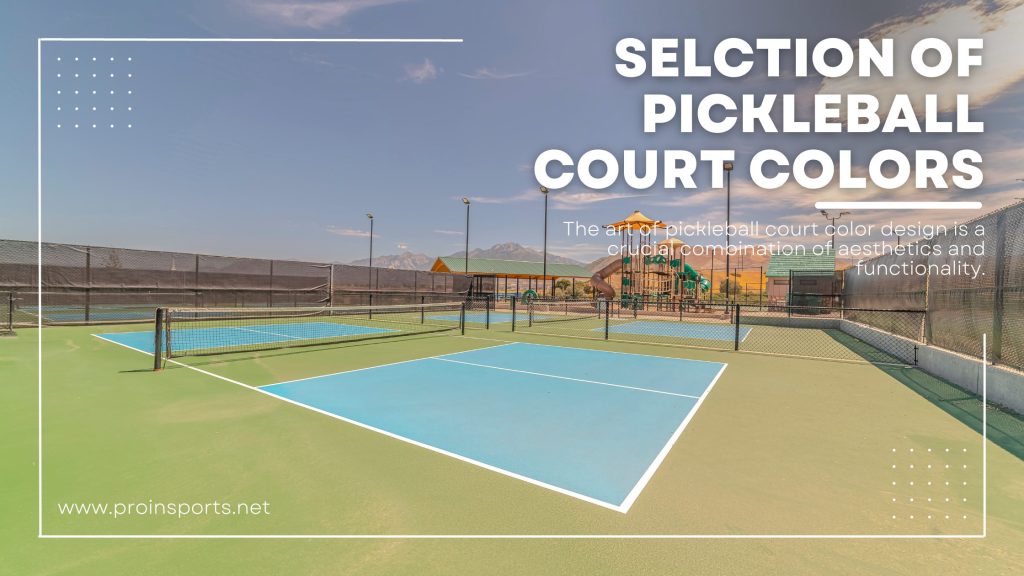Want to know about the Pickleball court colors? The shades and hues used to paint the court surface, and boundaries of a pickleball court are referred to as pickleball court colors. These colors are not only visually appealing, but they are key to the overall pickleball experience. Choosing the right colors, can improve visibility for players and help them keep track of the ball, as well as provide a pleasing aesthetic. Furthermore, appropriate court colors can align with official rules, creating a consistent play experience for all pickleball players.

Traditional Colors
The traditional colors of a pickleball court are blue/white or green/white. The playing surface is typically painted green or blue, while the lines and markings are white. These color combinations provide high visibility and contrast nicely with the pickleball color, making it easy for players to see the boundaries of the court and track the ball. Additionally, the green and white color scheme is consistent with the official regulations established by the governing bodies of the sport and is widely recognized as the standard for pickleball courts.

The US Pickleball Association (USAPA) allows for courts to be painted in any color as long as it contrasts with both the court lines and the ball. Jeff Gearheart, a pickleball expert, suggests that light-colored courts are more in demand in hot climates due to their reflective properties, as they can be up to 40 degrees cooler than darker courts. He notes that court colors should contrast well with the generally yellow or lime green pickleball balls for optimal play. Reds, purples, blues, greens, and other colors are also acceptable for court coloring.
Factors Must Take Into Consideration
Visibility
The visibility of court lines and markings is one of the most important factors to consider when choosing pickleball court colors. To ensure a safe and enjoyable playing experience, the colors used for the playing surface, lines, and markings must be bright and contrasting, thereby making it easy for players to see the court boundaries and track the ball; this, in turn, can help to prevent injuries due to poor visibility. Choosing the right colors for your court is essential for an enjoyable pickleball experience.
Players Safety
Player safety should be a primary concern for all pickleball players. Therefore, court colors should be taken into account when designing a court to ensure clear visibility, avoiding collisions between players and the boundaries of the court. Moreover, some colors may have a better grip, thus decreasing the chances of slips and falls. Consequently, safety should be prioritised when making decisions about court colors.
Maintenance Requirements for Each Color Option
Different court colors may require different levels of maintenance. For example, some colors may fade faster in the sun or show dirt and wear more easily, making it necessary to repaint the court more frequently. This should be considered when choosing a court color, as the maintenance requirements can affect the long-term cost of maintaining the court.
Cost for Different Colors
The cost of different court color options can vary depending on the materials and labor required. Some colors are more expensive to purchase or install, while some require more frequent maintenance. It is important to consider the total cost of ownership when choosing a court color, including the cost of initial installation and ongoing maintenance.
Aesthetics and Design of Surrounding
The pickleball court color should be carefully considered, as it should complement the surrounding space’s design and aesthetics and be harmonious with any other elements in the area. This will improve the overall visual appeal of the court and make it more inviting to players and spectators, thus creating a more pleasant experience for all.
Local Regulations or Ordinances Governing Court Color
Before selecting a color for a pickleball court, it is important to take into account any local regulations or ordinances that may be applicable. In some cities and communities, there may be particular color requirements for sports courts, and it is essential to adhere to these guidelines in order to ensure the court is in compliance with local laws and regulations. Therefore, it is prudent to consider any local regulations or ordinances before choosing a court color.
Best Color Combination For Pickleball Court
Some popular color combinations for pickleball courts include a combination of dark green, light green, and white. This combination will create a professional-looking court and can be used for either indoor or outdoor pickleball courts. Another popular color combination is a mix of blue, yellow, and white. This combination is great for a more playful, vibrant court and can create a great atmosphere for a friendly game.
FAQs
Final Verdict
The art of pickleball court color design is a crucial combination of aesthetics and functionality. By selecting the right colors, the overall pickleball experience can be improved visually and functionally. Traditional court colors are typically blue/white or green/white and provide high visibility, as the ball stands out against the bright contrast of the lines and markings. This allows players to easily keep track of the ball and be aware of the court’s boundaries, ultimately creating a consistent play experience for all pickleball players.
